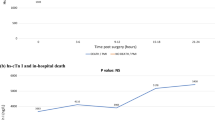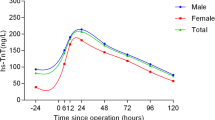Abstract
Measurement of cardiac markers is an index of care standard in the assessment and diagnosis of cardiovascualr disease. Two of the major cardiac markers are Creatine Kinase isoenzyme CK-MB and Troponin T, which are extensively used in the diagnosis of heart disease. The release of Troponin T and creatine kinase isoenzyme (CK-MB) was investigated in 50 coronary artery bypass surgery patients. Measurement of plasma samples was carried out at five different time points, namely before surgery, 1,6,12,24 hours after surgery. The results indicated that CK-MB level were increased by a factor more than four times compared with the upper limit of baseline (befor surgery). Troponin T concentration showed more than six fold over the upper limit of baseline (before surgert) at 1,6,12,24 hours after surgery. In order to assess the significance of the length of the surgical procedure on the release of Troponin T and CK-MB, the surgery patient were divided into two groups according to the length of the surgical procedure: group I was selected on the basis that the surgical procedure they underwent lasted above 90 minutes and group II with a surgical procedure below 90 minutes. Both Troponin T and CK-MB showed a significant increase in-group I compared to group II. To investigate the likelihood that this effect is party due to myocardial infarction during surgery, the patients were divided into two groups: Group A with some sings of myocardial infarction on Q wave of ECG and group B without any change. The results showed approximately a two-fold increase of these markers in-group A compared to group B. Since these markers reach into blood following damage to myocardial their increase in patients with time course surgery of more than 90 minutes and those with a probability of MI during operation, indicating that these patient fall into a high risk group of repeat (MI) after surgery.
Similar content being viewed by others
Abbreviations
- (CK-MB):
-
Creatine Kinase isoenzyme
- T(CTNT):
-
Cardiac Troponin
References
Higgins, S., Turner, A. and Wood, J. (1999) Biochemistry for the medical science. Chest pain. Editor: Thomas Devlin. Logman. p. 13–17.
Ooi, D.S., Isotalo, P.A. and Veinot, J.P. (2000) Correlation of ante mortem serum creatine kinase, Creatine kinase- MB, Troponin I, and troponin T with cardiac pathology. Clin. Chem. 46, 338–44.
Lehot, J., Durand, P.G. and Badtin, O. (1998) Isoenzyme in the diagnosis of myocardial infection after myocardial revascularization surgery. Ann. Fr. Anesth. Reanim. 7, 370–6.
Jain, U. (1995) Myocardial during reoperation for coronary artery bypass surgery J. Cardiotheorac. Vasc. Anesth. 9, 389–94.
Durfi, M. and Coworkers. (1998) Clinical data of Biochemistry: Editor. by Mordam. J. p. 324–332.
Wernovsky, G., (1998) Follow-up studies after the arterial switch operation. J. Thorac. Cardiovasc. Surg. 115, 481–2.
Immer, F.F., Stocker, F., Seiler, A.M., Pfammatter, J.P. and Printzen, G. (1999) Troponin I for prediction of early postoperative course after pediatric cardiac surgery J. Am. Coll. Cardiol. 33 1719–23.
Hirsch, R., Dent, C. L., Wood, M.K. and Huddeston, C.B. (1998) Patterns and potential value of cardiac troponin I elevation after pediatric cardiac operations. Ann. Thorac. Sur., 65, 1394–9.
Kessler-lcekson, G., Birk, E., Schlesinger, H. and Vidne, B.A. (1998) The myocardial profile of the cytosolic isozymes of cratine kinase is apparently not releated to cyanosis in congenital heart disease. Mol. Med. 5, 110–6.
Siegel, A. J., Sholar, M.J., Dhanak, E. and Lewandrowski, K.B. (1997) Elevated serum cardiac markers in asmptomatic marathon runners after competitions the myocardium. Cardiology 88, 487–91.
Kondo, K., Menohara, S., Sawada, Y., Irie, H., Okamato, K., Kinagasa, S., Nakao, M. and Sasaki, S. (1997) Indications and problems of coronary artery bypass grafting without cardiopulmonary bypass. Surrey Today 27, 202–6.
Tietz, N.W. (2003) Practice guideline for cardiac prolifing. Am. J. Clin. Pathol. 108, 696–9.
Fulda, G.J., Giberson, F., Hailstone, D., Law, A. and Stillabower, M. (1997) An evolution of serum troponin T and signal-averaged electrocardiography in predicting electrocardiographic abnormalities after blunt chest trauma. J. Trauma 43, 304–10.
Yeo, T.C., Malouf, J.F., Oh, J.K. and Seward, J.B. (1998) Clinical profile and outcome in 52 patients with cardiac psuedoaneursym. Ann. Intern. Med. 15, 299–305.
Garre, L., Alvarez, A., Rubio, M., Pellegrini, A., Caradi, M., Berardi, A. and Lazarro, C. (1997) Use of cardiac troponin T rapid assay in the diognosis of a myocardial injury secondary to electrical cardioversion. Clin. Cardiol. 20, 619–21.
Chaturvedi, R.R., Linclon, C., Gothard, J.W., Scallan, M.H., White, P.A., Redington, A.N. and Shor, D.F. (1996) Left ventricular dysfunction after open repair of simple congenital heart defects in infants and childeren:quantitation with the use of a conductance catheter immediately after bypass. J. Thorac. Cardiovasc. Surg. 115, 77–83.
Hassan, M.E., Azzazy, R.H. and Christenson, H. (2002) Cardiac markers of acute coronary syndromes: is there a case for point-of-care testing? Clin. Biochem 35, 13–27.
Costa, A.M. and Scallan, M.H. (2001) Heeding the Sign of Increased CK-MB Level After Bypass Surgery. Circulation 104, 2689–2693.
Newby, L.K., Storrow, A.B. and Gilbert, W.B. (2001) Bedside testing for risk stratification in chest pain units: Circulation 103, 1832–7.
Strrow, A.B and Gilber, W.B. (2000) Chest pain centres: diagnosis of acute coronary syndromes. Ann. Emerg. Med. 35, 449–61.
Takeda, S.K. and Ikezaki, H. (2002) Cardiac marker response t coronary artery bypass graft surgery with cardiopulmonary bypass and aortic cross-clamping. J. Cardiothorac. Vasc. Anesth. 16, 421–5
Fransen, E.J., Diris, J.H., Maessen, J.G., Hermens, W.T. and Van Dieijen-Visser, M.P. (2002) Evaluation of “new” cardiac markers for ruling out myocardial infarction after coronary artery bypass grafting. Chest 122, 1316–21.
Yamamoto, S., Takagi, Y., Gomi, K. and Takaba, T. (1995). Clinical significance of serum Troponin T following coronary artery bypass surgery. Rinsho Byori 43, 513–8.
Hisatomi, K., Isomura, T. and Aoyagi, S. (1996) Postoperative changes in myosin light chain and comparison with postoperative clinical variables in patients who have undergone valve surgery. Thorac. Cardiovasc. Surg. 44, 296–9.
Chen, T. and Pan, T. (2000) Variation of preoperative blood cTnT levels in patients undergoing cardiopulmonary bypass and its clinical implication. J. Tongi. Med. Univ. 20, 225–6.
Author information
Authors and Affiliations
Corresponding author
Rights and permissions
About this article
Cite this article
Mohiti, J., Behjati, M., Soltani, M.H. et al. The significance of troponin T and CK-MB release in coronary artery bypass surgery. Indian J Clin Biochem 19, 113–117 (2004). https://doi.org/10.1007/BF02872404
Issue Date:
DOI: https://doi.org/10.1007/BF02872404




